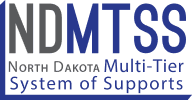History of NDMTSS
Important Dates & Milestones
Positive Behavior Intervention and Supports (PBIS) is specifically named in IDEA, beginning with the reauthorization of 1997, as well as in key guidance documents from the Department of Education. Notably, the IDEA states that the IEP team shall consider positive behavioral interventions and supports, and other strategies, when a student has behavior needs that impact their learning or the learning of others (20 U.S.C. § 1414(d)(3)(B)(i). State Educational Agencies are authorized to “provide training in the methods…positive behavioral interventions and supports to improve student behavior in the classroom” (IDEA, 20 U.S.C. § 1454(a)(3)(B)(iii)(I)).
In December 2009, the SEEC, in partnership with the Red River Valley Education Cooperative (RRVEC), was awarded a grant to “scale-up” implementation of Response to Intervention (RTI) and Positive Behavior Support (PBS) innovations in the 57 school districts and nearly 200 school buildings serviced by the two REAs. The grant award was for $150,000 over two years. A similar award was made to the Mid-Dakota Education Cooperative (MDEC) in partnership with the remaining five REAs.
In December 2009, the South East Education Cooperative (SEEC), in partnership with the Red River Valley Education Cooperative (RRVEC), was awarded a grant to “scale-up” implementation of Response to Intervention (RTI) and Positive Behavior Support (PBS) innovations in the 57 school districts and nearly 200 school buildings serviced by the two REAs. The grant award was for $150,000 over two years. A similar award was made to the Mid-Dakota Education Cooperative (MDEC) in partnership with the remaining five Regional Education Associations (REAs).
2011 ND Response to Intervention Conference: Responding to Student Needs was held on June 13-14, 2011 at the Fargo Holiday Inn in Fargo, ND. Over 300 teachers and administrators from across North Dakota and eastern Minnesota participated in outstanding, diverse and in-demand sessions designed to help school teams and practitioners gain a deeper understanding of what can be done to strengthen our classroom and school practices to meet the needs of all learners.
Build capacity in districts to assure adequate implementation supports for school leaders, staff, and teachers. In this way, the building leaders, teachers, and staff can make full and effective use of evidence-based programs when providing educational interventions to support positive student outcomes.
- Students cannot benefit from effective education practices they do not experience.
- An effective practice is only half of the formula for success; effective implementation support is the other half. Neither one is effective in educating students without the other.
Build capacity in state systems and regional organizations so they can develop the necessary district implementation supports.
- District staff cannot provide competent implementation supports to schools and teachers unless the district staff develop these new competencies themselves.
- In effect, the State and regional staff are using implementation strategies to develop implementation capacity in districts.
Goal 1: Pilot, implement, and scale-up PD for educators related to a Multi-Tier System of Supports (MTSS) that will result in improved academic and behavioral outcomes for students with disabilities.
Goal 2: Create and assess a statewide system of PD based on the principles of implementation science that will result in the regional delivery of high quality PD for educators in North Dakota.
“Increase the ability of teachers to effectively teach children with disabilities… and English learners, which may include the use of multi-tier systems of supports and positive behavioral intervention and supports” (Title II, Sec.2103(b)(3)(F))
“Providing for a multi-tier system of supports for literacy services” (Subpart 2, Title II, Sec. 2224(e)(4))
Professional development that “give teachers…knowledge and skills to provide instruction and academic support services…including positive behavioral interventions and supports, multi-tier system of supports, and use of accommodation” (Title VIII, Sec. 8002(42)(B)(xii) Title IX Redesignations

